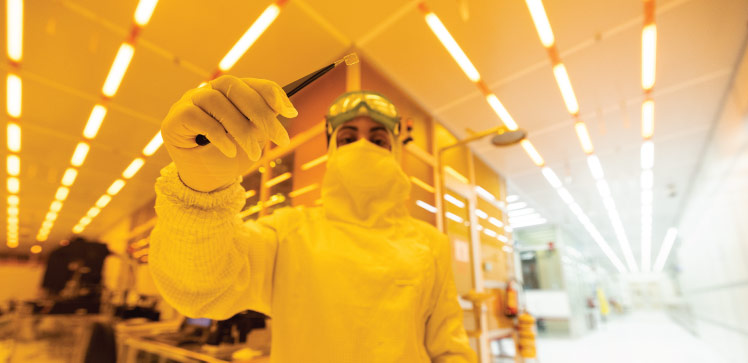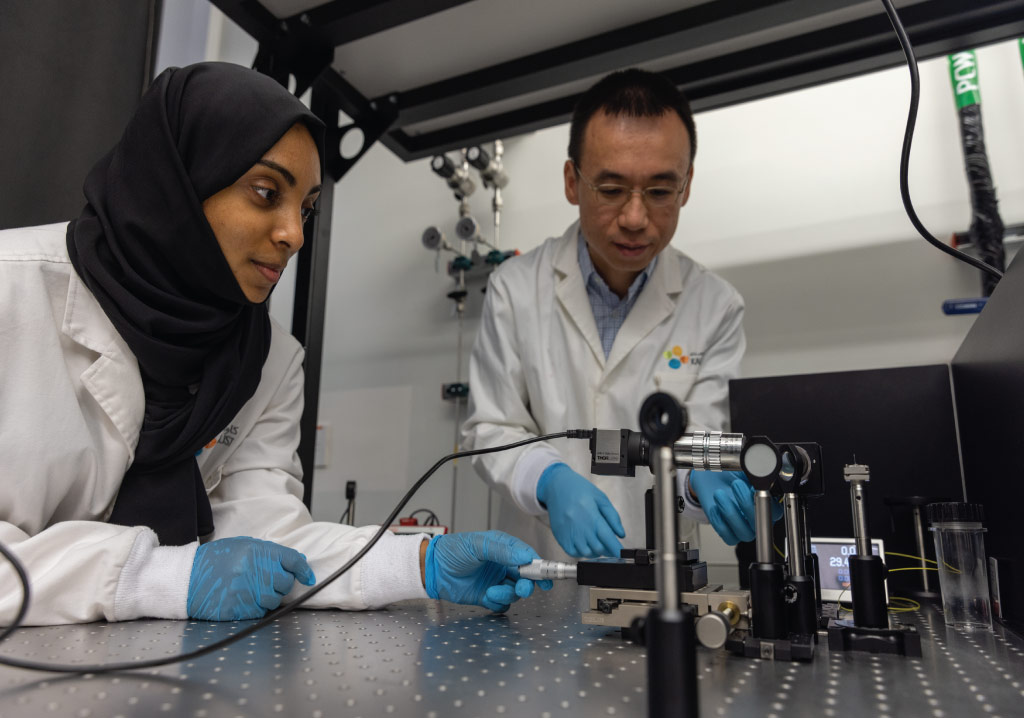Electrical Engineering
Metalens offers superior off-axis focus
A flat all-dielectric reflector metalens design could benefit optical imaging, manipulation and communications.

Learn how KAUST scientists are advancing semiconductor technology. © 2022 KAUST. /en/article/1290/metalens-offers-superior-off-axis-focus
An ultrathin dielectric metalens has been created that improves focusing capabilities but can also be scaled down to a tiny size for integration with photonics equipment.
Learn how KAUST scientists are advancing semiconductor technology. © 2022 KAUST. /en/article/1290/metalens-offers-superior-off-axis-focus
A metalens uses a metasurface to manipulate light. A flat lens, it offers a lightweight way to reduce the distortion often found in a curved lens.
The reflective lens, created by the KAUST team led by Xiaohang Li, was designed and fabricated from a custom-designed array of TiO2 nanopillars atop a Distributed Bragg Reflector (DBR). The DBR consists of a sandwich of alternating layers of SiO2 and TiO2.

The metalens developed by Ph.D. student Zahrah Alnakhli and Professor Xiaohang Li could benefit optical imaging, manipulation and communications.
© 2022 KAUST.
The resulting metalens is just 300μm in diameter and has a numerical aperture of 0.6 and a focal length of 200μm. “This metalens is a special arrangement of nanounit cells at the interface of the DBR, which is designed to reshape the reflected light wavefront by adjusting the location and refractive index of the surface nanounit cells,” explains Ph.D. student Zahrah Alnakhli. “This all-dielectric reflective metalens has negligible intrinsic loss and is easy to fabricate.”
The research showed that the metalens can efficiently focus red light, with a wavelength of 633nm, to a high-quality point for an incident beam with a normal angle of incidence. Importantly, and in contrast to many other lens designs, the focusing quality of the lens does not degrade significantly, even when the angle of the incident beam reaches up to 30 degrees. This enhanced off-axis focusing is significant as it could benefit a wide range of optical tasks spanning from optical tweezers to imaging.
“The off-axis focusing has many applications for optics of systems based on semiconductor LEDs, lasers and photodetectors for communication, display, imaging and others,” says Alnakhli. “One application is a super-long working distance that uses mirrors to increase the optical microscopy working distance. This is an important property of microscopic uses in industrial and biological inspections, where the working distance of traditional optical microscopy is challenging.”
To date, the KAUST team has only made lenses that operate at visible wavelengths, but Alnakhli says that in principle the approach can be applied to other spectral regions. “It is also possible to fabricate a DBR-metalens to operate in the infrared band of the spectrum but with different materials, such as germanium,” says Alnakhli. “Critically, the choice of nanopillar material depends on the complex refractive index of the material.”
In future, the KAUST team plans to further improve their metalens performance. “I am working to improve the focusing efficiency of the lens so that I can integrate it with other optoelectronic devices. This could enhance the directionality of the emitted beam for off-axis applications,” says Alnakhli.
References
- Alnakhli, Z., Lin, R., Liao, C-H., Labban, A.E. & Li, X. Reflective metalens with an enhanced off-axis focusing performance. Optics Express 30, 34117-34128 (2022).| article
You might also like

Bioengineering
Sensing stress to keep plants safe

Computer Science
Sweat-sniffing sensor could make workouts smarter

Electrical Engineering
New tech detects dehydration by touching a screen

Electrical Engineering
A new interface for efficient electronics

Electrical Engineering
Artificial neurons enable neuromorphic computing with light

Electrical Engineering
Narrow-linewidth lasers bring low-noise answer

Electrical Engineering
Octopus suckers inspire sticky medical patch

Electrical Engineering




